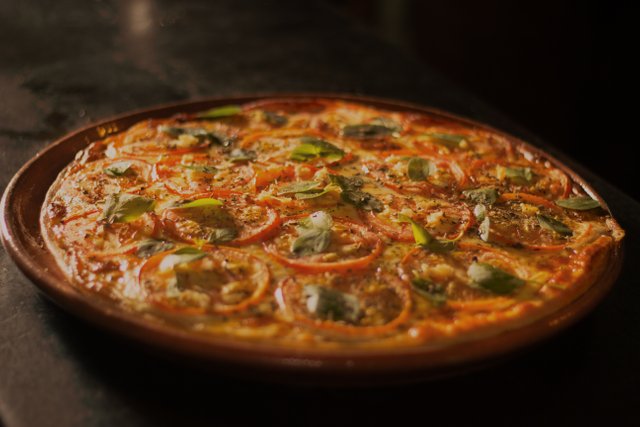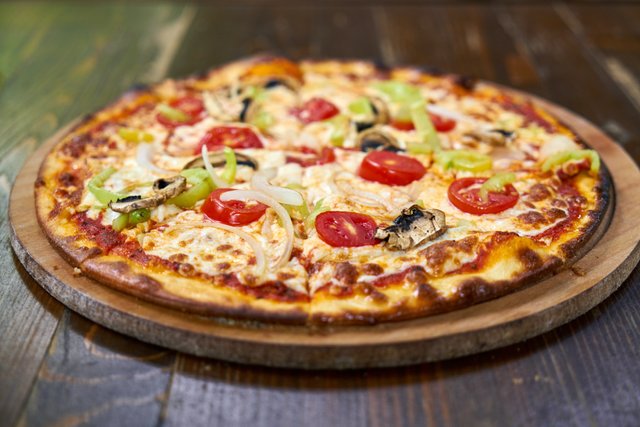Origins

In Sardinia, French and Italian archaeologists have found bread baked over 7,000 years ago. According to Philippe Marinval, the local islanders leavened this bread. Foods similar to pizza have been made since antiquity. Records of people adding other ingredients to bread to make it more flavorful can be found throughout ancient history.
In the 6th century BC, Persian soldiers serving under Darius the Great baked flatbreads with cheese and dates on top of their battle shields.
In Ancient Greece, citizens made a flatbread called plakous (πλακοῦς, gen. πλακοῦντος – plakountos) which was flavored with toppings like herbs, onion, cheese and garlic.

An early reference to a pizza-like food occurs in the Aeneid (c. 19 BC), when Celaeno, the Harpy queen, foretells that the Trojans would not find peace until they were forced by hunger to eat their tables (Book III). In Book VII, Aeneas and his men are served a meal that includes round cakes (like pita bread) topped with cooked vegetables. When they eat the bread, they realize that these are the "tables" prophesied by Celaeno.Some commentators have suggested that the origins of modern pizza can be traced to pizzarelle, which were kosher for Passover cookies eaten by Roman Jews after returning from the synagogue on that holiday, though some also trace its origins to other Italian paschal bread.
Abba Eban writes, "some scholars think [pizza] was first made more than 2,000 years ago when Roman soldiers added cheese and olive oil to matzah".Other examples of flatbreads that survive to this day from the ancient Mediterranean world are focaccia (which may date back as far as the ancient Etruscans); Manakish in the Levant, coca (which has sweet and savory varieties) from Catalonia, Valencia and the Balearic Islands; the Greek Pita; Lepinja in the Balkans; or Piadina in the Romagna part of Emilia-Romagna in Italy.

Foods similar to flatbreads in other parts of the world include Chinese bing (a wheat flour-based Chinese food with a flattened or disk-like shape); the Indian paratha (in which fat is incorporated); the Central and South Asian naan (leavened) and roti (unleavened); the Sardinian carasau, spianata, guttiau, pistoccu; and Finnish rieska. Also worth noting is that throughout Europe, there are many similar pies based on the idea of covering flat pastry with cheese, meat, vegetables and seasoning, such as the Alsatian flammkuchen, German zwiebelkuchen, and French quiche.
In 16th-century Naples, a galette flatbread was referred to as a pizza; it was known as a dish for poor people, particularly as street food, and was not considered a kitchen recipe until much later. It was not until the Spanish brought the tomato from the Americas and developed the modern variation that Pizzas in their modern conception were invented. It is said that the tomato reached the Kingdom of Naples and Sicily, at the time part of the Spanish Empire, through either Pedro Álvarez de Toledo in the 16th century or viceroy Manuel de Amat, who may have gifted some seeds to the Neapolitans in 1770 on behalf of the Viceroyalty of Peru.

In 1843, Alexandre Dumas described the diversity of pizza toppings. An often recounted story holds that on June 11, 1889, to honour the queen consort of Italy, Margherita of Savoy, the Neapolitan pizza maker Raffaele Esposito created the "Pizza Margherita", a pizza garnished with tomatoes, mozzarella, and basil, to represent the national colours of Italy as on the Flag of Italy. But the Pizza Margherita already existed: "The most popular and famous pizzas from Naples were the ‘Marinara’, created in 1734, and the ‘Margherita’, which dates from 1796-1810. The latter was presented to the Queen of Italy upon her visit to Naples in 1889, specifically on account of the colour of its seasoning (tomato, mozzarella and basil), which are reminiscent of the colours of the Italian flag."Pizza evolved into a variety of bread and tomato dish often served with cheese.

However, until the late 19th or early 20th century, the dish was sweet, not savory, and earlier versions that were savory resembled the flatbreads now known as schiacciata. Pellegrino Artusi's classic early-twentieth-century cookbook, La Scienza in cucina e l'Arte di mangiar bene gives three recipes for pizza, all of which are sweet. After the feedback of some readers, Artusi added a typed sheet in the 1911 edition (discovered by food historian Alberto Capatti), bound with the volume, with the recipe of "pizza alla napoletana": mozzarella, tomatoes, anchovies and mushrooms.However, by 1927, Ada Boni's first edition of il talismano della felicità (a well-known Italian cookbook) includes a recipe using tomatoes and mozzarella.
"photos from pexels"
Hola @afnan1234
Te escribo para notificarte que está publicación arrojo plagio, las imágenes utilizadas no son de tu autoría y no contienen el link de dónde fueron tomadas.
El contenido muestra una cierta cantidad de plagio tomado de:
https://www.khtheat.com/blog/
https://en.wikipedia.org/wiki/History_of_pizza/
https://magdalenespizza.com/pizza-stuff/history-of-pizza/
Y otras páginas, por tal motivo será silenciado. Te invito a realizar los.logros de la Comunidad Newcomers Community para conocer más sobre la plataforma.
Muchas gracias.
Cc @adeljose
@steemcurator01
Downvoting a post can decrease pending rewards and make it less visible. Common reasons:
Submit